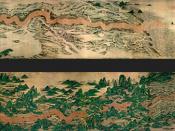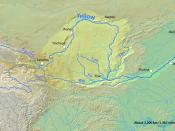The Yellow River, also known as Huang He, is located in Northern Central China. It is the second longest river in China. It carries yellow sandy silt, called loess, which gives the river its name (Dramer, 2001, p.7). It carries its rich yellow silt from Mongolia to the Pacific Ocean (Spielvogel, 2005, p.85). The Huang He is sometimes called "The Great Sorrow" because of suffering brought by its floods (Ellis, Esler, 2001, p. 111). Millions of people have drowned, towns have been destroyed, and crops have been ruined because of the flooding (Dramer, 2001, p. 8). However, the silt deposits brought by the floods have made the northern plains a rich agricultural area. Many sites on the banks of the Yellow River reflect China's three major philosophies; Buddhism, Daoism, and Confucianism (Dramer, 2001, p. 31).
The northeastern part of the Tibetan plateau is where the Yellow River rises. The Chinese saw the Yellow River as a barrier to setting up communities in the area.
Some scholars believe this is the origin of China's imperial dynasties. The Yellow River valley civilization was the start to the many Chinese Empires. The need to control the rushing waters of the Yellow River is an often used explanation to the rise of Chinese civilization. The waters were so rough that the Chinese couldn't build bridges across and hand to travel the river using sheepskin sacks filled with air (Dramer, 2001, pp.13-15). The Yellow River has also been an important source of life. Aside from being the main source of water for millions of farmers, the yellow river has been a vital route of transportation and communications. In North and Western China it was one of the main 'highways' transportation and communications. It was the only way to travel large distances at reasonable speed. Ships...


